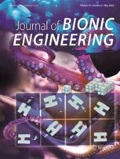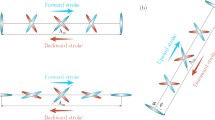Abstract
Wing deformation capture with simulation is a mixed experimental-numerical approach whereby the wing deformation during flapping is captured using high-speed cameras and used as an input for the numerical solver. This is an alternative approach compared to pure experiment or full fluid structure interaction simulation. This study is an update to the previous paper by Tay et al., which aims to address the previous limitations. We show through thrust and vorticity contour plots that this approach can simulate Flapping Micro Aerial Vehiclex (FMAVs) with reasonable accuracy. Next, we use this approach to explain the thrust improvement when an additional rib is added to the original membrane wing, which is due to longer duration for the new wing to open during the fling stage. Lastly, by decreasing the number of points and frames per cycle on the wing, we can simplify and shorten the digitization process. These results show that this approach is an accurate and practical alternative which can be applied to general bio-inspired research.
Similar content being viewed by others
References
Nguyen Q V, Chan W L, Debiasi M. Hybrid design and performance tests of a hovering insect-inspired flap-ping-wing micro aerial vehicle. Journal of Bionic Engineering, 2016, 13, 235–248.
de Croon G C H E, Perçin M, Remes B D W, Ruijsink R, De Wagter C. The DelFly: Design, Aerodynamics, and Artificial Intelligence of a Flapping Wing Robot, Springer, 2016.
Keennon M, Klingebiel K, Won H, Andriukov A. Tailless flapping wing propulsion and control development for the nano hummingbird micro air vehicle. American Helicopter Society Future Vertical Lift Aircraft Design Conference, San Francisco, USA, 2012, 1–24.
Festo. BionicOpter — Inspired by dragonfly flight 2013, [2020-06-10], https://www.festo.com/group/en/cms/10224.htm
Ryu S W, Lee J G, Kim H J. Design, fabrication, and analysis of flapping and folding wing mechanism for a robotic bird. Journal of Bionic Engineering, 2020, 17, 229–240.
Kumar D, Mohite P M, Kamle S. Dragonfly inspired nanocomposite flapping wing for micro air vehicles. Journal of Bionic Engineering, 2019, 16, 894–903.
He W, Wang T, He X, Yang L J, Kaynak O. Dynamical modeling and boundary vibration control of a rigid-flexible wing system. IEEE/ASME Transactions on Mechatronics, 2020, DOI:https://doi.org/10.1109/tmech.2020.2987963
van Oudheusden B W, Scarano F, Casimiri E W F. Non-intrusive load characterization of an airfoil using PIV. Experiments in Fluids, 2006, 40, 988–992.
Tronchin T, David L, Farcy A. Loads and pressure evaluation of the flow around a flapping wing from instantaneous 3D velocity measurements. Experiments in Fluids, 2015, 56, 7.
Tian F B, Dai H, Luo H, Doyle J F, Rousseau B. Fluid-structure interaction involving large deformations: 3D simulations and applications to biological systems. Journal of Computational Physics, 2014, 258, 451–469.
Nakata T, Liu H. A fluid-structure interaction model of insect flight with flexible wings. Journal of Computational Physics, 2012, 231, 1822–1847.
Riskin D K, Willis D J, Iriarte-Diaz J, Hedrick T L, Kostandov M, Chen J, Laidlaw D H, Breuer K S, Swartz S M. Quantifying the complexity of bat wing kinematics. Journal of Theoretical Biology, 2008, 254, 604–615.
Viswanath K, Nagendra K, Cotter J, Frauenthal M, Tafti D K. Straight-line climbing flight aerodynamics of a fruit bat. Physics of Fluids, 2014, 26, 021901.
Song J, Luo H, Hedrick T L. Flow characteristics of a hovering hummingbird. Proceeding of the 31st AIAA Applied Aerodynamics Conference, San Diego, USA, 2013, 1–12.
Tay W B, de Baar J H S, Percin M, Deng S, van Oudheusden B W. Numerical simulation of a flapping micro aerial vehicle through wing deformation capture. AIAA Journal, 2018, 56, 3257–3270.
Nguyen Q V, Chan W L, Debiasi M. Development of an insect-inspired flapping-wing micro air vehicle capable of vertical take-off and hovering. International Conference on Intelligent Robots and Systems, Chicago, USA, 2014, 1–6.
Nguyen Q V, Chan W L, Debiasi M. Experimental investigation of wing flexibility on force generation of a hovering flapping wing micro air vehicle with double wing clap-and-fling effects. International Journal of Micro Air Vehicles, 2017, 9, 187–197.
Weis-Fogh T. Quick estimates of flight fitness in hovering animals, including novel mechanisms for lift production. The Journal of Experimental Biology, 1973, 59, 169–230.
Jadhav S S, Lua K B, Tay W B. Effect of clap-and-fling mechanism on force generation in flapping wing micro aerial vehicles. Bioinspiration & Biomimetics, 2019, 14, 036006.
Hedrick T L. Software techniques for two- and three-dimensional kinematic measurements of biological and biomimetic systems. Bioinspiration & Biomimetics, 2008, 3, 034001.
Caetano J V, Percin M, Oudheusden B W van, Remes B, de Wagter C, de Croon G C H E, de Visser C C. Error analysis and assessment of unsteady forces acting on a flapping wing micro air vehicle: free flight versus wind-tunnel experimental methods. Bioinspiration & Biomimetics, 2015, 10, 056004.
Hedrick T L. Wing inertia and whole-body acceleration: An analysis of instantaneous aerodynamic force production in cockatiels (Nymphicus hollandicus) flying across a range of speeds. Journal of Experimental Biology, 2004, 207, 1689–1702.
Mittal R, Iaccarino G. Immersed boundary methods. Annual Review of Fluid Mechanics, 2005, 37, 239–261.
Yang J, Balaras E. An embedded-boundary formulation for large-eddy simulation of turbulent flows interacting with moving boundaries. Journal of Computational Physics, 2006, 215, 12–40.
Kim J, Kim D, Choi H. An immersed-boundary finite-volume method for simulations of flow in complex geometries. Journal of Computational Physics, 2001, 171, 132–150.
Liao C C, Chang Y W, Lin C A, McDonough J M. Simulating flows with moving rigid boundary using immersed-boundary method. Computers & Fluids, 2010, 39, 152–167.
Garmann D J, Visbal M R, Orkwis P D. Three-dimensional flow structure and aerodynamic loading on a low aspect ratio, revolving wing. 42nd AIAA Fluid Dynamics Conference and Exhibit, New Or-leans, USA, 2012, 1–22.
Tay W B, Percin M, van Oudheusden B, Bijl H, Cetiner O, Unal M. Numerical and experimental analysis of tandem flapping flight. 43rd Fluid Dynamics Conference, San Diego, USA, 2013, 1–24.
Hunt J C R, Wray A A, Moin P. Eddies, streams, and convergence zones in turbulent flows. Proceedings of the Summer Program, Stanford, USA, 1988, 193–208.
Acknowledgment
The computational work for this article was done on resources of the National Supercomputing Computer, Singapore (https://www.nscc.sg). The authors wish to thank the National Supercomputing Computer for their kind support.
Author information
Authors and Affiliations
Corresponding author
Rights and permissions
About this article
Cite this article
Tay, WB., Jadhav, S. & Wang, JL. Application and Improvements of the Wing Deformation Capture with Simulation for Flapping Micro Aerial Vehicle. J Bionic Eng 17, 1096–1108 (2020). https://doi.org/10.1007/s42235-020-0100-x
Published:
Issue Date:
DOI: https://doi.org/10.1007/s42235-020-0100-x




